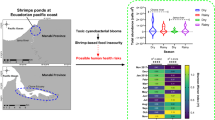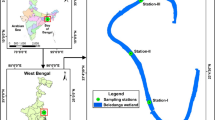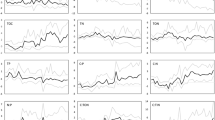Abstract
The planktonic rotifer biomass and abundance in two trace metal-contaminated, acidified lakes were compared with that of six non-acidic lakes in central Ontario, Canada, which had low levels of metals. Rotifers, especially Keratella taurocephala Myers, were an order of magnitude more abundant in the acidified lakes. They composed 16 to 51% of the total zooplankton biomass in these lakes, but <2% in the non-acidic lakes. Recent experimental work supports a hypothesis that the great abundance of rotifers in the acidic lakes is attributable to a reduction in densities of crustacean competitors.
Similar content being viewed by others
References
Ahlstrom, E. H. 1943. A revision of the rotatorian genus Keratella with descriptions of three new species and five new varieties. Bull. Am. Mus. nat. Hist. 80: 411–457.
Almer, B., W. Dickson, C. Ekström, E. Hörnström & U. Miller, 1974. Effects of acidification on Swedish lakes. Ambio 3: 30–36.
Beamish, R. J. & H. H. Harvey, 1972. Acidification of the La Cloche Mountain Lakes, Ontario, and resulting fish mortalities. J. Fish. Res. Bd. Canada. 29: 1131–1143.
Brandl, Z. & C. H. Fernando, 1978. Prey selection by the cyclopoid copepods Mesocyclops edax and Cyclops vicinus. Verh. Internat. Verein. Limnol. 20: 2505–2510.
Buikema, A. L., Jr., J. Cairns, Jr. & G. W. Sullivan, 1974. Evaluation of Philodina acuticornis (Rotifera) as a bioassay organism for heavy metals. Wat. Res. Bull. 10: 648–661.
Chengaleth, R. & C. H. Fernando, 1973. The planktonic rotifera of Ontario with records of distribution and notes on some morphological variation. Can. Field Nat. 87: 267–277.
Confer, J. L., T. Kaaret & G. E. Likens, 1983. Zooplankton diversity and biomass in recently acidified lakes. Can. J. Fish. Aquat. Sci. 40: 36–42.
Dillon, P. J., N. D. Yan, W. A. Scheider & N. Conroy, 1979. Acidic lakes in Ontario, Canada: Characterization, extent and responses to base and nutrient additions. Arch. Hydrobiol. Beih., Ergebn. Limnol. 13: 317–336.
Eriksson, M. O. G., L. Henrikson, C. I. Nilsson, G. Nyman, H. G. Oscarson & A. E. Stenson, 1980. Predator-prey relations important for the biotic changes in acidified lakes. Ambio 9: 248–249.
Foran, J. A. & R. H. King, 1982. A regression analysis of the summer population dynamics of Polyarthra vulgaris in a northern Michigan bog lake. Hydrobiologia 94: 237–246.
Hobaek, A. & G. G. Raddum, 1980. Zooplankton in acidified lakes in south Norway. Rep. IR 75/80. SNSF Project, 132 pp.
Keller, W. & J. R. Pitblado, 1984. Crustacean plankton in north eastern Ontario lakes subjected to acidic deposition. Water, Air Soil Pollut. (in press).
Likens, G. E. & J. J. Gilbert, 1970. Notes on quantitative sampling of natural populations of planktonic rotifers. Limnol. Oceanogr. 15: 816–820.
Makarewicz, J. C. & G. E. Likens, 1979. Structure and function of the zooplankton community of Mirror Lake, New Hampshire. Ecol. Monogr. 49: 109–127.
Marshall, J. S. & D. L. Mellinger, 1980. Dynamics of cadmium-stressed plankton communities. Can. J. Fish. Aquat. Sci. 37: 403–414.
Neill, W. E., 1984. Regulation of rotifer densities by crustacean zooplankton in an oligotrophic mountain lake in British Columbia. Oecologia (Berlin) 61: 175–181.
Ontario Ministry of the Environment, 1982. Studies of lakes and watersheds near Sudbury, Ontario, 2. Appendices.
Pastorok, R. A., 1980. Selection of prey by Chaoborus larvae: a review and new evidence for behavioural flexibility. In W. S. Kerfoot (ed.), Evolution and Ecology of zooplankton communities: 538–554.
Roff, J. C. & R. E. Kwiatkowski, 1977. Zooplankton and zoobenthos of selected northern Ontario lakes of different acidities. Can. J. Zool. 55: 899–911.
Scheider, W. A., J. Adamski & M. Paylor, 1975. Reclamation of acidified lakes near Sudbury, Ontario. Ont. Min. Envir. 129 pp.
Schindler, D. W., 1969. Two useful devices for vertical plankton and water sampling. J. Fish. Res. Bd. Can. 26: 1948–1955.
Schindler, D. W. & B. Novén, 1971. Vertical distribution and seasonal abundance of zooplankton in two shallow lakes of the Experimental Lakes Area, northwestern Ontario. J. Fish. Res. Bd. Can. 28: 245–256.
Smith, R. W. & D. G. Frey, 1971. Acid mine pollution effects on lake biology. U.S. E.P.A., Wat. Pollut. Cont. Res. Ser. 18050 EEC 12/71, 129 pp.
Sprules, W. G., 1975. Midsummer crustacean zooplankton communities in acid-stressed lakes. J. Fish. Res. Bd. Can. 32: 389–395.
Stemberger, R. S., 1979. A guide to rotifers of the Laurentian Great Lakes. U.S. Envir. Prot. Ag. Rep. EPA-600/4-79-021, 186 pp.
Stockinger, N. F. & H. A. Hays, 1960. Plankton, benthos and fish in three strip-mine lakes with varying pH values. Trans. Kansas Acad. Sci. 63: 1–10.
Stoneburger, D. L. & L. A. Smock, 1980. Plankton communities of an acidic, polymictic brown water lake. Hydrobiologia 69: 131–138.
Traaen, T. S., 1980. Effects of acidity on decomposition of organic matter in aquatic environments. In D. Drablos & A. Tollan, (eds.), Ecological impact of acid precipitation. SNSF Project, Oslo: 340–341.
Uéno, M., 1958. The disharmonious lakes of Japan. Verh. internat Verein. Limnol. 13: 217–226.
Yan, N. D., 1979. Phytoplankton community of an acidified, heavy metal-contaminated lake near Sudbury, Ontario: 1973–1977. Water Air Soil Pollut. 11: 43–55.
Yan, N. D. & R. Strus, 1980. Crustacean zooplankton communities of acidic, metal-contaminated lakes near Sudbury, Ontario. Can. J. Fish. Aquat. Sci. 37: 2282–2293.
Yan, N. D. & G. E. Miller, 1984. Effects of deposition of acids and metals on chemistry and biology of lakes near Sudbury, Ontario. In J. Nriagu (ed.), Environmental Impacts of Smelters. John Wiley & Sons, Inc.: 243–282.
Yan, N. D., C. J. Lafrance & G. G. Hitchin, 1982. Planktonic fluctuations in a fertilized, acidic lake: The role of invertebrate predators. In R. E. Johnson (ed.), Acid Rain/ Fisheries. Proc. int. Symp. Acidic Rain & Fish. Impacts in N.E. N. America: 137–154.
Yan, N. D., R. W. Nero, W. Keller & D. C. Lasenby, 1984. Are Chaoborus larvae more abundant in acidified Canadian lakes? Holarctic Ecol. (in press).
Author information
Authors and Affiliations
Rights and permissions
About this article
Cite this article
Yan, N.D., Geiling, W. Elevated planktonic rotifer biomass in acidified metal-contaminated lakes near Sudbury, Ontario. Hydrobiologia 120, 199–205 (1985). https://doi.org/10.1007/BF00045163
Received:
Revised:
Accepted:
Issue Date:
DOI: https://doi.org/10.1007/BF00045163




